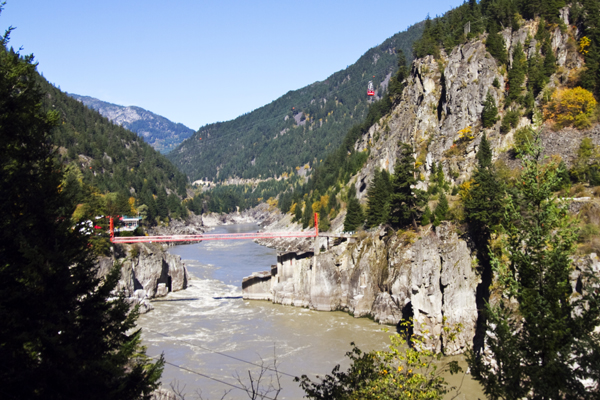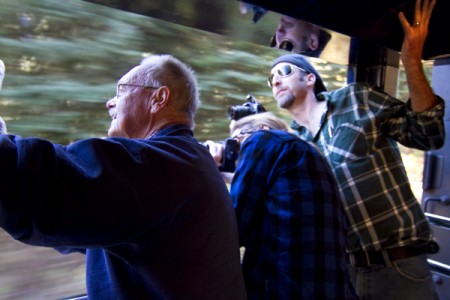I am standing outside on the viewing platform on the train when we are suddenly enveloped in darkness as we pass through the tunnel that leads to Hell’s Gate, so named by Simon Fraser, after whom this river and valley are named, in 1808 because he said it reminded him of the “Gates of Hell.”
About this narrow part of the river, where some 200 million gallons of water forces its way through the narrow canyon, Fraser wrote in his diary, “We had to pass where no human being should venture.”
Antoine has alerted every one on the coach to get their cameras ready and suddenly the viewing platform is jammed as everyone elbows themselves into a spot on the right side of the train to snap pics of both the whitewater and the Swiss-built tram which carries tourists 500 feet up the opposite side of the gorge.
Antoine tells us that when Canadian Pacific built this section of the rail line in the 1880s, they had to lower men on ropes and makeshift ladders down the walls of the canyon so they could drill holes in the rock, stuffing them with dynamite, and then hope they’d be hauled back up to the top before the explosion went off.
“Usually they made it,” he says. “Sometimes they didn’t.”
This whole endeavor—building a railway line from one end of Canada to the other—was crazy. So much vast wilderness to survey and map, and then find the best route and sometimes you came to areas like Hell’s Gate and there just weren’t any options so, what the hell, build it anyway. And the money. Back in 1885, in the midst of construction, Canadian Pacific ran out of cash. They stopped paying their construction crews. This was a private company, mind you. So they went to the Canadian government for funding. And were bailed out. And as a result, the construction continued. And was completed later that year. A transcontinental railway, one of the engineering wonders of the world, running from Montreal to Vancouver. When the first train left Montreal’s Dalhousie Square Station on June 28, 1886, it covered the 3,000 mile journey in 139 hours and arrived in British Columbia only one minute late. Imagine.
Tags: Canada, Rocky Mountaineer



Recent Comments